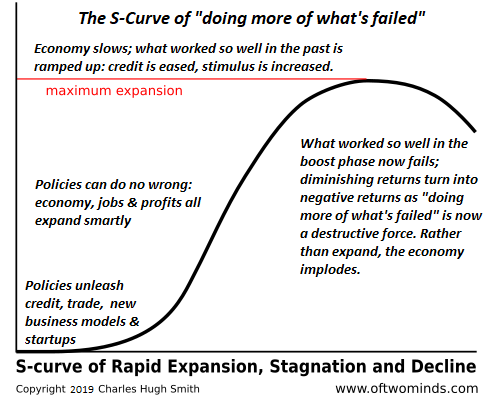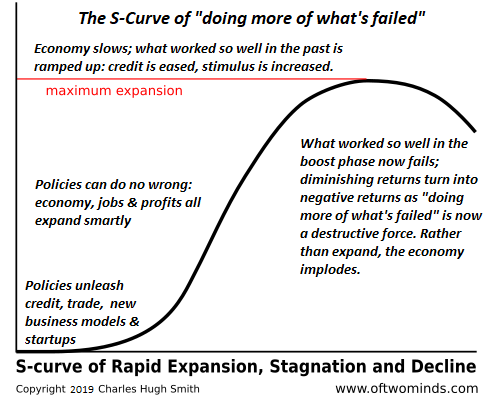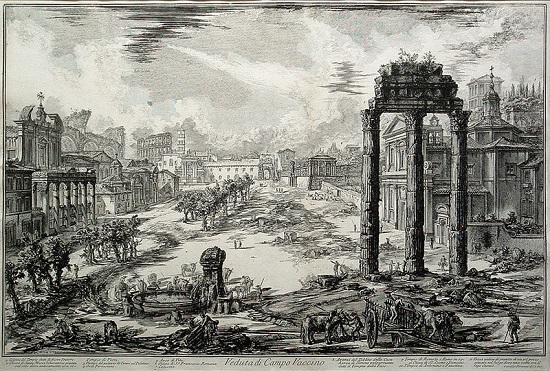
The fragmentation, simplification and localization of the post-Imperial age offers us lessons we disregard at our danger.
There is a whole industry committed to “why the Roman Empire collapsed,” but the post-collapse age might be offer us higher value lessons. The post-collapse period, long crossed out as The Dark Ages, is better understood as a period of adaptation to altering conditions, particularly, the relocalization and simplification of the economy and governance.
As historian Chris Wickham has described in his books Middle ages Europe and The Inheritance of Rome: Illuminating the Dark Ages 400-1000, the medieval age is best understood as an intricate procedure of social, political and economic natural selection: while the Western Roman Empire unwinded, the Eastern Roman Empire (Byzantium) continued for nearly 1,000 years after the fall of the Western Roman Empire, and the social and political structures of the Western Roman Empire influenced Europe for hundreds of years.
In broad-brush, the Roman Empire was a highly centralized, tightly bound system that was extremely adaptive in spite of its massive size and the slow pace of transportation and interaction. Roman society was both extremely hierarchical– the elites declared superiority and strove to master the required tools of authority– slaves were essential to the structure and upkeep of Rome’s vast facilities– and available to meritocracy, as the Roman Army and other classes were open to improvement by anybody in the stretching empire: every complimentary person became a Roman Resident once their territory was soaked up into the Empire.
When the Empire broke down, the model of central control/power continued on in the reigns of the so-called Barbarian kingdoms (Goths, Vandals, etc) and Charlemagne (768-814), over 300 years after the fall of Rome. (When the Ottomans finally conquered Constantinople in 1453, they likewise adopted a number of the administrative structures of the Byzantine Empire.)
Gradually, however, the feudal model of localized fiefdoms nominally loyal to a weak central monarchy replaced the central model of governance. This adjustment fit the highly fragmented nature of European societies in this age.
But central influence never ever disappeared. The Christian churches based in Rome and Constantinople continued to put in central impact in politically fragmented areas, and monarchies continued to exist, in numerous states of strength and weak point. The Holy Roman Empire– as Voltaire is deemed to have observed, “neither Holy, Roman or an Empire”– had a tremendously intricate history in Germany and the rest of Europe. The monarchies in England and France stayed in location, and the city-states of northern Italy wielded influence via trade and moving alliances.
To put it simply, the Middle ages era was eventually an intricate competitors in between overlapping models of governance and sharing resources, a competitors in between centralized and localized (what Wickham calls “cellular”) nodes of power and the numerous ways that rulers and those they ruled handled each other.
Throughout the age, the legitimacy of rulers ultimately flowed from public assemblies, a custom inherited from Rome that manifested in aristocratic courts and the church’s management (bishops, etc) and ultimately, in parliaments. This tension played out in the sharing of costs and resources and the basic instructions of the state.
As a general rule, when kings consolidated too much power, they engaged in catastrophically costly and doomed wars (The A Century War) due to the fact that they had the ability to override or overlook the mindful counsel of elite assemblies.
Understood as a selective process of adjusting to altering situations, this history uses us valuable lessons and templates for our future.
When the centralized power of Rome fragmented, economic, social and political power streamlined and relocalized. Trade volume shrank and trade routes vanished. When the administrative and military structures determined by Rome collapsed, areas and regions were on their own.
Elites naturally sought out the very best methods to combine and broaden their power, and citizens (as a basic guideline, the peasantry and town-dwellers) sought to improve their own lives by reducing costs and protecting access to resources.
The enormous geographic, cultural, social and financial diversity of Europe was in effect freed to play out. This variety is still obvious; the European Union might have combined the European financial system, however cultural and social departments have actually not dissolved.
Wickham compares two main income sources and wealth accessible to elites and federal governments: land and taxes. Collecting taxes requires a tremendous bureaucracy to determine and assess homeowner, occupant farmers, merchants, gather duties on trade flows, etc. Taxes are the only reputable way to fund expert armies and the stupendous administration needed to manage an intricate central empire. The Byzantine Empire made it through several rivals, intrusions, and so on mostly due to its proficient taxation administration, and European monarchies might only money long, pricey wars once they established tax collection administrations.
Wealth from land– surplus skimmed from the labor of peasants– was adequate to money highly localized nobility (much of which had one or two castles and a small fiefdom), however it wasn’t dependable sufficient or big enough to support professional armies or large centralized states.
How does this history offer a design template for the next 20 years?
I have actually long held that the dominant worldwide forces binding the global economy are globalization and financialization. Both have considerably increased the income and wealth that nation-states can tax to money their vast structures: military, social welfare, and bureaucracies of management, guideline and control.
I have actually also held that globalization and financialization became hyper-structures vulnerable to over-extension and the lessening returns of the S-Curve. (see chart listed below) Both have reversed and are now in decline, a decrease that I prepare for will accelerate unpredictably and rapidly as each dynamic is centralized and securely bound, suggesting each subsystem is highly adjoined with other subsystems. Ought to one break, the entire system unwinds.
Globalization might appear to be decentralized, but the huge majority of worldwide trade and capital flows through a few central nodes, and many aspects of trade depend on an extremely little number of paths and suppliers. This makes global trade exquisitely sensitive to interruption must any important provider or node stop working.
Financialization is equally central and securely bound, to the absurd degree that unknown financial structures (reverse repos, and so on) can activate cascading crises in the real-world economy.
I anticipate a global simplification of trade and financing as vulnerable hyper-structures collapse as the failure of subsystems waterfall through the entire system.
These systems have considerably sped up extremes of wealth-income inequality by their very nature, and these large distortions and imbalances are unsustainable. Likewise unsustainable is the tremendous expansion of the plundering of the world’s remaining resources through globalization and financialization. These characteristics will collapse under their own weight.
What will be left? As soon as the earnings and wealth that supported tremendously expensive nation-state governments contracts, main governments will no longer have the ability to money their colossal systems. (States that try to fund their activities by printing cash will only speed the collapse of their finances and therefore their coherence.)
As in the post-Roman age, central authority may well continue, but its real power and influence will be significantly lowered. Without expanding income and wealth to tax, the main state might attempt to draw out most of the nation’s surplus, however this stripmining of elites and citizens alike will activate pushback and revolt.
A more sustainable reaction would be to unload most of the main federal government’s monetary burdens onto states, provinces, counties, and so on, in effect pushing the difficult task of keeping entitlements and promised spending on regional entities.
Provided the variety of cultures, social worths and economic characteristics in big countries and areas, we can expect a blooming of adjustments to these significantly lowered ways. Some regions will favor increasing authoritarian controls, others will prefer reducing authoritarian controls and delivering authority to the smallest systems of public assembly.
Places (shall we call them fiefdoms?) will divide naturally along geographic borders, just as fiefdoms in middle ages Europe fell into natural limits formed by rivers, valleys, range of mountains, and so on, and along economic and cultural borders.
This relocalization might manifest in the popular projections of the US breaking into numerous local states, or it might manifest as I suggest in a much-weakened however still influential main government delivering power to regional political structures which may themselves piece or type alliances with close-by entities with whom they share cultural and economic ties.
To put it simply, a churn of evolutionary adaptations can be expected. Just as there was no one post-Roman adaptation that worked equally well all over, we can anticipate there to be some adjustments of approximately equivalent success and numerous that are not successful.
As people and families, we wish to be found in successful adaptations that share our values and provide us company, i.e. a say in public assemblies and the freedom to move and work as we see fit.
As I have described often times in the blog site and in my books, areas that are extremely dependent on long worldwide supply chains and remote capital for their essentials will fare really badly when those supply chains break and the capital dries up. Regions and locations that produce their own fundamentals (food, energy, metals, concrete, electronics, etc), talent and capital are a lot more likely to produce adequate resources to please both local elites and the general public.
As I explain in my book Self-Reliance, we who have lived in the past 75 years of broadening production and consumption of Whatever have lost touch with both the natural world that sustains us and the social and useful skills required to endure and succeed in an age in which the engines of central power and wealth (globalization and financialization) decay and collapse.
Some places will pick to cultivate relocalization and private firm. Others will stick on to stopping working models of authoritarian control and globalization/ financialization.
Ironically, perhaps, the most successful regions will be vulnerable to delighting in hubris and denial, just as the Roman elites, basking in their centuries of supremacy, dismissed the “Barbarians” and clung to their misconceptions of magnificence even as their world fragmented around them.
Those areas left by globalization and financialization may well provide much better chances for successful adjustment, relocalization and individual/ home agency.
It is humanity to discover reasons to dismiss the storm clouds on the horizon. We take a look around and discover solace in the apparent strength of our institutions and economy, while disregarding their sobering dependence on unsustainable hyper-globalization and hyper-financialization.
The fragmentation, simplification and localization of the post-Imperial era offers us lessons we disregard at our hazard. It is necessary to see these lessons not just as a scholastic abstraction but as a guide to your own choices about what locations are most favorable to your security and wellness. Not every locale will do equally well, and the culture of numerous locations might not be a great match for your own worths and goals. If you decide to move, faster is much better than later.
This essay was drawn from my Weekly Musings Reports sent specifically to subscribers, clients and Substack subscribers. Thank you quite for supporting my work.


 My brand-new book is now readily available at a 10 % discount rate($8.95 ebook,$ 18 print): Self-Reliance in the 21st Century. Check out the very first chapterfor free(PDF) Check out excerpts of all three chapters Podcast with Richard Bonugli: Self Reliance in the 21st Century (43 min)My
My brand-new book is now readily available at a 10 % discount rate($8.95 ebook,$ 18 print): Self-Reliance in the 21st Century. Check out the very first chapterfor free(PDF) Check out excerpts of all three chapters Podcast with Richard Bonugli: Self Reliance in the 21st Century (43 min)My
current books: The Asian Heroine Who Seduced Me(Unique)
print$10.95, Kindle$ 6.95 Check out an excerpt free of charge (PDF)
When You Can’t Go On: Burnout
, Numeration and Renewal$ 18 print,$ 8.95 Kindle ebook; audiobook Check out the first section free of charge(PDF)International Crisis, National Renewal: A(Revolutionary )Grand Strategy for the United States(Kindle$9.95, print$24, audiobook)Read Chapter One totally free (PDF ). A Hacker’s Teleology: Sharing the Wealth of Our Diminishing Planet(Kindle$ 8.95, print$20, audiobook$17.46)Check out the first area for free(PDF). Will You Be Richer or Poorer?: Revenue, Power, and AI in a Traumatized World
(Kindle $5, print$10, audiobook) Check out the very first area for free(PDF). The Adventures of the Consulting Thinker: The Disappearance of Drake
(Unique)$4.95 Kindle,$ 10.95 print); checked out the very first chapters totally free (PDF)Cash and Work Unchained $6.95 Kindle,$15 print)Read the first area totally free End up being a$1/month patron of my work through patreon.com. Subscribe to my Substack
for free KEEP IN MIND: Contributions/subscriptions are acknowledged in the order got.
Your name and e-mail remain confidential and will not be given to any other private, company or agency. Thank you, Max J.($5/month ), for your marvelously generous pledge to this site– I

